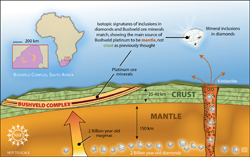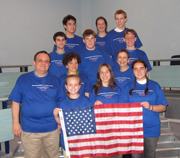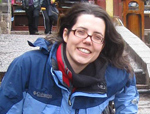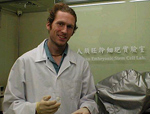Each month, the NSF Current newsletter highlights research and education efforts supported by the National Science Foundation. If you would like to automatically receive notifications by e-mail or RSS when future editions of NSF Current are available, please use the links below:
![]() Subscribe to NSF Current by e-mail |
Subscribe to NSF Current by e-mail | ![]() What is RSS?
What is RSS?

Revisiting a once-abandoned technique, engineers at the Massachusetts Institute of Technology (MIT) have successfully created a novel, yet simple, method of turning ordinary pieces of glass into efficient solar concentrators.
Electrical engineer Marc Baldo, his graduate students Michael Currie, Jon Mapel and Timothy Heidel, and postdoctoral associate Shalom Goffri, announced their findings in the July 11, 2008, issue of Science.
The researchers create the concentrators by coating glass with carefully chosen mixtures of dyes. The dyes absorb incoming light and re-emit the energy into the glass, which can channel the light to solar cells placed along the edges of the concentrator. This technique will effectively enable smaller solar cells to harvest the same amount of energy as larger, more costly solar cells.
"We think this is a practical technology for reducing the cost of solar power," said Baldo.
Because the starting materials are affordable and relatively easy to scale up beyond a laboratory setting, the researchers believe the technology could soon find its way to the marketplace.
To learn more about the concentrators, see the NSF press release.

Micropyretics Heaters International, Inc. (MHI), the recipient of three NSF small business innovation research (SBIR) grants, is a small company making a big impact on the world of specialty high-temperature heating elements. MHI manufactures MoSi2 (molybdenum disilicide), silicon carbide and other specialized heating elements and furnaces using the latest advanced materials. The company is unique in keeping its profitable manufacturing operations exclusively within the United States.
MHI attributes its success in part to SBIR grants from NSF. The investment is paying off in a number of ways; not only is MHI now turning a profit, it is also keeping manufacturing jobs in the U.S. and providing a needed service to customers both within the U.S. and abroad.
According to MHI chief operating officer Anu Vissa, "MHI invests all its available earnings into the market driven R&D demand. I feel that this is one key reason why we have been able to become a high tech exporter in our business. Companies like us could do a lot better with assistance and thereby provide better social return."

In addition to their usual role as symbols of enduring love and fidelity, diamonds are now also helping geologists unravel clues about how the earth's precious metal mineralization was formed.
In a paper published in Nature, researchers from the Carnegie Institution and the University of Cape Town presented their findings after studying 2-billion-year-old diamonds mined near the famed Bushveld Complex, a unique geological formation in South Africa. After analyzing mineral inclusions within the diamonds, the researchers believe both the diamonds and the magmas that gave rise to the Bushveld Complex have an ancient subcontinental mantle source.
For more information, see the NSF press release.

Bats are proving to have a surprising role in helping scientists understand aspects of the human brain and nervous system.
Cynthia Moss, a member of the Neuroscience and Cognitive Science program at the University of Maryland, College Park, Md., is one of few researchers who spend time trying to get into the heads of bats. Her new research suggests there is more to studying bats than figuring out how they process sound to distinguish environments.
"Our review highlights new research findings suggesting that the bat's vocal production does more than yield echoes," says Moss. "We're learning every time the bat produces a vocalization, there are changes in brain activity that are essential to complex behaviors." The research could ultimately help neurobiologists understand environmental perception, memory, and spatial planning in other mammals, including humans.
For more information, see the NSF press release.
The United States will be represented for a second year in a row at the 6th annual International Linguistics Olympiad (ILO) held in Bulgaria from August 4-9, 2008. Last year was the first time the ILO had teams representing the U.S. The American teams were impressive in their debut, winning several awards including a share of the top team prize with Russia. The U.S. teams are chosen from the top eight finalists in the North American Computational Linguistics Olympiad (NACLO) held on February 8, 2008.
For more information about last year's team, see the NSF press release.

One of NSF's hallmark international programs is the East Asia and Pacific Summer Institutes program or EAPSI. EAPSI was started by NSF in 1990 to introduce U.S. graduate students to the exciting science, engineering and research activities of East Asian and Pacific universities and research institutions. In June 2008, Singapore joined the half dozen other counties (Australia, Japan, Korea, Taiwan, New Zealand and China) already hosting graduate students in the program. To date, EAPSI has engaged 1,400 participants.


Three EAPSI fellows have published "Behind the Scenes" accounts at LiveScience.com, in which they describe their personal experiences doing research and living abroad. Their stories are also featured on the NSF Discoveries Web site.
Abigail Watrous -- During the summer of 2007, Abigail Watrous conducted research at Tsinghua University in China where she investigated alternative cooking and heating fuels for use in rural China. Commonly used household fuels such as coal produce harmful carbon dioxide (CO2) and soot, but most people in rural China cannot afford other more expensive fuel options. Watrous sought a practical, effective and affordable alternative fuel that would reduce CO2 emissions and improve human and planetary health.

Christopher Cherry -- Christopher Cherry spent the summer of 2005 studying the impacts of electric bikes in China. He examined the social, economic and environmental impacts of electric bikes, including their potentially negative environmental effects, as well as the increased access they provide to jobs, shopping and health care opportunities.
Mike Wininger -- Mike Wininger's background in physics and mathematics meant that he was the only member of Dr. Wannhsin Chen's stem cell engineering group who had no experience culturing human embryonic stem cells. But that lack of experience gave him an opportunity to learn a brand-new skill. According to Wininger, "the work was everything that I had been trained to do: to interface with researchers in the basic sciences, and to synthesize the experience within the universe of biomedical engineering."
Scientist Models Molecular Switch (ScienceDaily, 6/17/2008) -- Michigan Technological University physicist Ranjit Pati and his team have developed a model to explain the mechanism behind computing's elusive Holy Grail, the single molecular switch.
NSF Funds Search for Keys to Life's Greatest Secrets (About.com – News and Issues, 6/19/2008) -- NSF has awarded four grants to fund research leading to answers for "enduring questions of life." While these studies may not tell you why 12 socks go into the dryer and only 11 come out, they may reveal the history and future of life on earth.
Newly Born Twin Stars Are Far From Identical (7th Space Interactive, 6/7/2008) -- NSF-funded basic research may cause astronomers to re-examine the masses and ages of young stars and star formation theories.

If you have ever wondered what it's really like in the Antarctic, Emmy Award-winning filmmaker Anne Aghion's documentary, Ice People, paints an accurate picture. Aghion and her team braved the extreme temperatures and isolation from the outside world to capture the intense environment of the world's southernmost continent.
Ice People was produced with a grant from NSF's Antarctic Artists and Writers Program, which provided an unprecedented opportunity for Aghion and her team. This is the first time NSF has allowed a film crew to spend such an extended time in the field.
The film mainly chronicles scientists Allan Ashworth and Adam Lewis of North Dakota State University as they embark on a collaborative research project studying ancient lake deposits in the western Dry Valleys of Antarctica. Ashworth, Lewis and coworkers discovered 'freeze-dried' moss over 14 million years old--a huge breakthrough suggesting the frigid continent was once green. The Antarctic is emerging as a valuable resource, with discoveries there becoming increasingly important in understanding global climate patterns.
Ice People chronicles not only the scientific breakthroughs occurring in Antarctica but also the dedication and passion of professionals in the field.
According to Aghion, "Ice People is a film about our complex relationship to nature and the creative, and innately human, drive to explore, discover and understand. Being there makes you look at the earth in a new light, and inspires you to think in profound and different ways about your own place in the world."
To learn more about Ice People, visit the documentary's Web site.
On June 30th, 2008, the President signed the War Supplemental Bill into law, which includes $62.5 million for NSF.

NSF's Research and Related Activities account receives an additional $22.5 million, of which $5 million is designated for the Experimental Program to Stimulate Competitive Research (EPSCoR) program. The Education and Human Resources directorate receives a total of $40 million for the Robert Noyce Scholarship program.
For the latest news on NSF & Congress, visit the NSF & Congress Web site.

